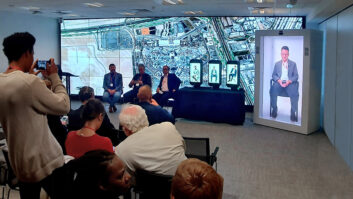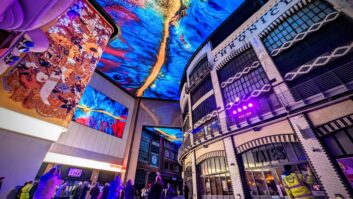When the US president is photographed wearing 3D glasses – as he was in late April – it seems reasonable to assume that 3D is becoming increasingly pervasive. Certainly, few can be unaware of the rapid growth in interest in 3D for the cinema, with Hollywood and movie theatres having made substantial investments in the technology. But will 3D become mainstream throughout the AV industry? Will we see videoconferencing, visitor attractions, control rooms, digital signage and even boardrooms routinely equipped with a 3D capability?
What applications will drive the 3D displays market that Displaybank says will be worth $15.8 billion in 2015 (compared with $140 million in 2008) and will, in six years time, represent over 9% of the total market for displays?
Depending on which source you believe, Hollywood has announced that it will create at least a dozen 3D movies this year – and perhaps twice that number. Studios such as DreamWorks and Disney have said that all their upcoming movies will be 3D. Cinema-goers will, it seems, typically pay a 20% premium to see the 3D version of a film. 3D is also providing the spur for wide-scale adoption of digital cinema – something that Hollywood believes is essential for the future health of the industry.
Whether the success of 3D in the cinema can be replicated in homes remains to be seen. TV manufacturers, like the Hollywood studios, are anxious to find new ways of getting us to part with our money. HD and digital TV have provided a significant revenue opportunity in the past few years – but now, TV manufacturers are looking for ‘the next big thing’.
Facing the future
Many companies – including Samsung, Sony, LG and Panasonic, who showed 3D TVs at this year’s Consumer Electronics Show – believe that 3D could be the future. Some, such as the Samsung and Mitsubishi units, are based on DLP rear projection – while Panasonic has demonstrated 3D plasma. Whichever technology is used, however, the viewer is required to wear glasses – which is also true for 3D in cinemas. That’s a pivotal issue for 3D in the future.
Inevitably, there is significant research and development taking place to create screens that can deliver 3D images – but without glasses. Leading companies here include Newsight, VMJ, Mitani Corporation and Opticality. They must have shuddered when Philips announced in April that it was closing its 3D solutions division and discontinuing production of displays using its glass-less WOWvx technology. Those who had seen WOWvx in action were, for the most part, impressed, with demonstrations at ISE showing its potential for commercial applications.
At the time of its announcement, Philips said that widespread adoption of 3D consumer TVs was likely to happen much later than it had forecast – and this, together with the recessionary economic environment, meant that the 3D effort was no longer viable.
Approach with caution
This caution is reflected by other major players, such as NEC. “3D will be increasingly important for our digital cinema business,” says Barrie Guy, sales manager, public display and retail solutions at NEC Display Solutions.
He adds that he wasn’t surprised by the Philips decision, “but we are not chasing 3D flat screen business, and have no plans to bring out product for this market at the moment.”
In terms of 3D applications, Ray McGroarty, Polycom’s EMEA director for solutions and product marketing, doesn’t see 3D as part of his business – at least, not yet. “This year, 3D won’t have an impact on our business,” he says, “but we’re actively investigating the possibilities for 3D in videoconferencing. We’ll probably roll out some form of 3D in our telepresence solutions in the next five years, and it will move down the line over time.”
But there are others in the industry to whom 3D is already an important part of their business. “We focus on complex media technologies and the convergence of IT and AV,” says Blair Parkin, founder and managing director of consultancy Visual Acuity. “3D technology is a normal part of our working day!”
“We have a long history of providing equipment for 3D theatres and attractions,” says Henry Corrado of Alcorn McBride, which specialises in the provision of audio, video, lighting and show control for themed entertainment. “This type of attraction is now affordable for smaller parks and museums, so most of the expansion we’re seeing is in that mid- to low-end market.”
Engineering opportunities
Another AV market that has long embraced the benefits of 3D technology is engineering, where 3D provides valuable insight that supports the interpretation and design process. “We certainly see 3D becoming increasingly important for our business,” notes Mark Clowes, European marketing manager for 4K projection at Sony, “in line with the market’s increasing appetite for 3D across a number of applications such as high-end visualisation, particularly in car design.” He goes on to point out the increasing acceptance of his company’s 4K resolution projection technology in digital cinema, driven to a large extent by 3D’s need for higher resolutions (because 3D, in effect, halves the available resolution as it needs twice as many pixels to create separate right eye and left eye images).
“Christie has a long history working in the automotive industry supporting design and testing applications for the likes of Mercedes, DaimlerChrysler and BMW,” says Larry Paul, senior director, solutions and product management, visual environments at Christie. “In more recent years, this has spread to the aerospace industry with Airbus using Christie systems to model the interior of their aircraft for different layouts and ‘skins’ for different airlines. These are high-end systems using sophisticated tracking, but Christie systems are also being used in low-cost applications.”
At ITEC in May, projectiondesign showcased its F10 AS3D active 3D projector, demonstrating the possibilities of 3D in a simulation and training environment. “Right now, we are investing a lot in marketing 3D to educate and stimulate our specialist and niche markets,” says Trond Solvold, product and application manager, 3D and medical at projectiondesign. “We are actively working on new solutions and different future platforms to be able to cater for niche markets such as medical imaging, simulation, films and post production.”
Solvold refers to ‘niche’ markets – and thus far, that’s where 3D has had most of its success. “3D can be applied to a host of mainstream applications, but it only makes sense if it answers the big question: will 3D add value to my business?” says Clowes. “For many of the applications we are involved in, the answer is ‘yes’. The automotive industry is utilising 3D systems at 4K to reduce costs by speeding up the development time for new models, the oil and gas industry is talking in terms of potentially saving millions of dollars through the use of 3D seismic data analysis to improve drilling success rates, and we are beginning to see our high-end technology providing definable benefits to areas such as medical training.”
But what of the broader opportunity? The question on many people’s lips is: ‘What about digital signage?’ “3D technology has been evolving for many years,” says Jason Shave, European sales manager at Dynamax Technologies. “We saw the first real deployments in an out-of-home environment several years back, where crowds gathered around an in-store display for minutes at a time. That’s the holy grail of dwell time for advertisers!”
“The only barrier I see to a commercial application being successfully deployed is the determination by a company to really go for it,” he continues. “But the fundamental truth doesn’t change, whether it’s 2D or 3D: content is king. Repurposed 2D content will work, but it still looks 2D. Quite simply, it’s making sure the content created is fit for purpose.”
This point is developed by Peter Critchley, managing director of The Beaver Group. “For 3D digital signage to succeed, it needs to demonstrate that its positive effect is even greater than traditional digital signage if the additional investment is to be justified,” he says. “Today, that evidence doesn’t exist – and without it, 3D in digital signage is likely to be little more than a gimmick.”
Creating appropriate content that really leverages the potential of 3D is only one of many challenges that will determine the extent to which it becomes part of the AV mainstream. Another is that the 3D industry as a whole is plagued by a lack of agreement on standards. A third is that it is still relatively expensive.
Recurring concern
But the issue to which the industry constantly returns is the issue of glasses. For limited exposure, controlled applications such as cinema and visitor attractions, or even visualisation, the occasional, temporary use of glasses is acceptable.
McGroarty can’t see how the videoconferencing ‘illusion’ of everyone being in the same room can be maintained when everyone is wearing glasses. But for the kind of ‘casual’ viewing that is the digital signage paradigm, the way forward has to be in screens that can be viewed without glasses – like Philips’ ill-fated WOWvx. Even here, though, much work needs to be done in terms of angle of view, susceptibility to ambient light, resolution, contrast and cost. That work is under way, and is key to 3D becoming more prevalent.
What is most difficult to determine, however, is the extent to which the market for 3D technology for commercial applications will be driven by the consumer market. If Philips was wrong, and the consumer electronics market applies the full force of its R&D capability to 3D, then standards will be created earlier, content will become more plentiful – and prices will go down.
Paradoxically, however, if consumers become blasé about 3D, then it will have lost some of its wow factor for applications such as digital signage. On the other hand: the shorter viewing time of digital signage – compared with TV – means that glassless viewing is more practicable, as eye strain is less of an issue, and this may see 3D used out of home more widely than in home.
Regardless, however, of whether the future holds 3D signage in every supermarket, airport or shopping mall, 3D technology has without doubt established itself widely within the AV industry where it is helping create solutions that deliver real value.







